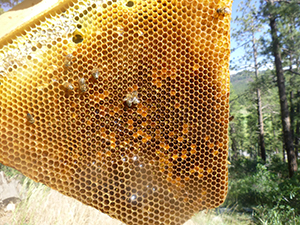
Our main goal as beekeepers is to help the bees do what they want to do. This is a much more successful paradigm than trying to make the bees do what we want them to do. What the bees are doing right now is preparing for winter. Actually, that is what they have been doing since the end of swarm season, but the closer it gets to winter, the easier it is for us humans to understand. Using good colony management to help our bees prepare for winter is pretty important to their survival.
So, what do bees need for winter? Could we just leave them alone and they would get it right? Unfortunately, unless they live in a hollow tree, the answer to this question is, probably not. The shape and size of standard Langstroth bee hives are quite different from hollow trees. In September, our bees need to be storing their honey and bee bread (pollen) for the winter. Without encouragement, they will leave outer frames empty, and put everything they bring in into supers. This looks great to humans, but we need to think about the bees first. In most areas, supers need to come off of the hive early enough that the bees will begin back-filling the brood chamber well before the honey flow is over. A full-sized colony will need two deeps or three mediums for brood and honey. If outer frames are empty, move them in one space to help the bees remember to fill them. This is important because full honey frames hold heat gained during the day, and release it at night, helping mimic the thicker walls of a hollow tree.
Remember that bees need pollen in the hive over winter, too. This is the high protein food that the nurse bees need to produce royal jelly to feed the brood during late winter and early spring. Pollen also contains vitamins, sterols, and other nutrients necessary, not only to nurse bees, but also to larval bees. Leave frames with bee bread at the edges of the cluster.
The next management issue we can help our bees with is placement of the brood chamber as fall progresses. An open screened bottom makes regulation of temperature and humidity of the brood chamber difficult for the bees. They may begin storing honey below the brood chamber in an effort to insulate it from cold, dry air. Putting the sliding solid bottom in place will help them with this. The closed solid bottom is as effective as the open screen, if it has something sticky on it to trap the mites that are groomed or fall onto it. Vaseline works great for this, and won’t attract mice as lard might. If the bees have already begun to place honey below brood, September is your chance to rearrange the comb and place the honey above the brood. The reason we do this is because the bees will begin winter on the brood chamber, and then follow the honey upward. If part of the honey is above them, and part below, they’ll get into the upper hive body, and not move down when it is cold, even if there is plenty of honey right below them.
Horizontal beekeeping in top bar and long Langstroth hives requires the same type of comb management. In summer, the bees will usually have one sheet of honey at the door, followed by one sheet of bee bread, and then the brood chamber, with most of the honey toward the back. As fall progresses, the bees begin….


